Explainable Risk Assessment of Rockbolts’ Failure in Underground Coal Mines Based on Categorical Gradient Boosting and SHapley Additive exPlanations (SHAP)
Abstract
1. Introduction
2. Case Study
3. Methods
3.1. Model-Building Process
3.2. Categorical Boosting (Catboost)
3.3. SHapley Additive exPlanations (SHAP)
4. Results and Discussion
4.1. Classification Performance
4.2. SHAP Global Interpretation
- Figure 8a indicates that rockbolts with “length of roadway” greater than 30 m are more likely to fail (i.e., SHAP values > 0). The risk even increases when the roadway is located in “zone 2”.
- In Figure 8b, one can observe that rockbolts existing in “headgate 1” are less likely to fail, and vice versa.
- Again, rockbolts with a “stress factor” value less than 0.3 are less likely to fail (Figure 8c). The probability of failure decreases even further when the rockbolts are located at “headgate 2”. However, the risk of failure increases with increasing “stress factor”.
- Figure 8d shows that rockbolts with age of less than 5 years are very unlikely to fail. After 5 years, the risk of failure increases with time.
- In Figure 8e, it can be seen that rockbolts located in “cut-through 2” are more likely to fail. Additionally, bolts in “cut-through 2” within “zone 2” have a higher risk of failure.
- According to Figure 8f, rockbolts in “zone 1” with a “length of roadway” less than 20 m are more likely to fail.
- Rockbolts in “zone 2” and “zone 3” are less likely to fail, as shown in Figure 8g,h, respectively.
- The “dripper flow rate” generally has less impact on bolt failure; however, a “dripper flow rate” of 40–60 mL/h together with a low “stress factor” could potentially cause failure (Figure 8i).
- The risk of failure in “headgate 2” is very low and is even more unlikely to fail when “headgate 2” is located in “zone 2” (Figure 8j).
- Figure 8k shows that rockbolts located in “cut-through 1” have the potential to fail, although the probability is less.
- Figure 8l shows that “headgate 3” generally does not have a serious impact on failure.
4.3. SHAP Local Interpretation
5. Conclusions
- “Length of roadway” was found to be the greatest contributing factor to the failure outcome, followed (in decreasing order of importance) by “headgate 1”, “stress factor”, “age of bolts”, “cut-through 2”, “zone 1”, “zone 2”, “zone 3”, “dripper flow rate”, “headgate 2”, “cut-through 1”, and “headgate 3”.
- Rockbolts with a “length of roadway” greater than 30 m are more likely to fail. This risk increases even further when groundwater with high sulphur content is present.
- Rockbolts with a service age less than 5 years are very unlikely to fail. After 5 years, the risk of failure increases with time.
Author Contributions
Funding
Institutional Review Board Statement
Informed Consent Statement
Data Availability Statement
Acknowledgments
Conflicts of Interest
References
- Hebblewhite, B.; Lu, T. Geomechanical behaviour of laminated, weak coal mine roof strata and the implications for a ground reinforcement strategy. Int. J. Rock Mech. Min. Sci. 2004, 41, 147–157. [Google Scholar] [CrossRef]
- Emery, J.; Canbulat, I.; Zhang, C. Fundamentals of modern ground control management in australian underground coal mines. Int. J. Min. Sci. Technol. 2020, 30, 573–582. [Google Scholar] [CrossRef]
- Craig, P.; Ramandi, H.L.; Chen, H.; Vandermaat, D.; Crosky, A.; Hagan, P.; Hebblewhite, B.; Saydam, S. Stress corrosion cracking of rockbolts: An in-situ testing approach. Constr. Build. Mater. 2021, 269, 121275. [Google Scholar] [CrossRef]
- Sakhno, I.; Sakhno, S.; Isaienkov, O.; Kurdiumow, D. Laboratory studies of a high-strength roof bolting by means of self-extending mixtures. Min. Miner. Depos. 2019, 13, 17–26. [Google Scholar] [CrossRef]
- Peter, K.; Moshood, O.; Akinseye, P.O.; Martha, A.; Khadija, S.O.; Abdulsalam, J.; Ismail, L.A.; Emman, A.A. An overview of the use of rockbolts as support tools in mining operations. Geotech. Geol. Eng. 2021, 40, 1637–1661. [Google Scholar] [CrossRef]
- Małkowski, P.; Niedbalski, Z.; Majcherczyk, T.; Bednarek, Ł. Underground monitoring as the best way of roadways support design validation in a long time period. Min. Miner. Depos. 2020, 14, 1–14. [Google Scholar] [CrossRef]
- Krykovskyi, O.; Krykovska, V.; Skipochka, S. Interaction of rock-bolt supports while weak rock reinforcing by means of injection rock bolts. Min. Miner. Depos. 2021, 15, 8–14. [Google Scholar] [CrossRef]
- Jing, H.; Wu, J.; Yin, Q.; Wang, K. Deformation and failure characteristics of anchorage structure of surrounding rock in deep roadway. Int. J. Min. Sci. Technol. 2020, 30, 593–604. [Google Scholar] [CrossRef]
- Tang, B.; Cheng, H. Application of distributed optical fiber sensing technology in surrounding rock deformation control of tbm-excavated coal mine roadway. J. Sens. 2018, 2018, 8010746. [Google Scholar] [CrossRef]
- Singh, R.N.; Heidarieh Zadeh, A.M. Rock Bolt Reinforcement System to Stabilise Shaft Intersections and Pit Bottom Roadways during Underground Reconstruction. In Proceedings of the The 23rd US Symposium on Rock Mechanics (USRMS), OnePetro, Berkeley, CA, USA, 25 August 1982. [Google Scholar]
- Tsusaka, K.; Yamasaki, M.; Hatsuyama, Y. Rock deformation and support load in shaft sinking in horonobe url project. In Proceedings of the ISRM Regional Symposium-EUROCK 2009, OnePetro, Cavtat, Croatia, 29 October 2009. [Google Scholar]
- Beus, M. An approach to field testing and design of deep mine shaft in the western USA. In Shaft Engineering; Institute of Mining and Metallurgy: London, UK, 2005; pp. 58–68. [Google Scholar]
- Waclawik, P.; Snuparek, R.; Kukutsch, R. Rock bolting at the room and pillar method at great depths. Procedia Eng. 2017, 191, 575–582. [Google Scholar] [CrossRef]
- Merwe, V.d.; Nielen, J.; Madden, B.J.; Buddery, P. Rock engineering for underground coal mining: A practical guide for supervisors at all levels, mine planners and students. S. Afr. Inst. Min. Metall. 2010, 7, 30–31. [Google Scholar]
- Craig, P.; Serkan, S.; Hagan, P.; Hebblewhite, B.; Vandermaat, D.; Crosky, A.; Elias, E. Investigations into the corrosive environments contributing to premature failure of australian coal mine rock bolts. Int. J. Min. Sci. Technol. 2016, 26, 59–64. [Google Scholar] [CrossRef]
- Hebblewhite, B.; Fabjanczyk, M.; Gray, P. Premature Rock Bolt Failure, Acarp Project no C8008. In Australian Coal Association Research Program; Australian Coal Association: Australia, 2002. [Google Scholar]
- Crosky, A.; Smith, B.; Hebblewhite, B. Failure of rockbolts in underground mines in australia. Pract. Fail. Anal. 2003, 3, 70–78. [Google Scholar] [CrossRef]
- Crosky, A.; Smith, B.; Elias, E.; Chen, H.; Craig, P.; Hagan, P.; Vandermaat, D.; Saydam, S.; Hebblewhite, B. Stress corrosion cracking failure of rockbolts in underground mines in australia. In Proceedings of the 7th International Symposium on Rockbolting and Rock Mechanics in Mining, Aachen, Germany, 30–31 May 2012. [Google Scholar]
- Wu, S.; Ramandi, H.L.; Chen, H.; Crosky, A.; Hagan, P.; Saydam, S. Mineralogically influenced stress corrosion cracking of rockbolts and cable bolts in underground mines. Int. J. Rock Mech. Min. Sci. 2019, 119, 109–116. [Google Scholar] [CrossRef]
- Jiang, P.; Craig, P.; Crosky, A.; Maghrebi, M.; Canbulat, I.; Saydam, S. Risk assessment of failure of rock bolts in underground coal mines using support vector machines. Appl. Stoch. Models Bus. Ind. 2018, 34, 293–304. [Google Scholar] [CrossRef]
- Sun, X.-y.; Kang, F.-n.; Wang, M.-m.; Bian, J.-p.; Cheng, J.-l.; Zou, D. Improved probabilistic neural network pnn and its application to defect recognition in rock bolts. Int. J. Mach. Learn. Cybern. 2016, 7, 909–919. [Google Scholar] [CrossRef]
- Zheng, H.-Q.; Yang, Y.-R.; Sun, X.-Y.; Wen, C. Nondestructive Detection of Anchorage Quality of Rock Bolt Based on DS-DBN-SVM. In Proceedings of the 2018 International Conference on Machine Learning and Cybernetics (ICMLC), Chengdu, China, 15–18 July 2018; pp. 288–293. [Google Scholar]
- Singh, S.K.; Raval, S.; Banerjee, B. Roof bolt identification in underground coal mines from 3d point cloud data using local point descriptors and artificial neural network. Int. J. Remote Sens. 2021, 42, 367–377. [Google Scholar] [CrossRef]
- Kamrunnahar, M.; Urquidi-Macdonald, M. Prediction of corrosion behaviour of alloy 22 using neural network as a data mining tool. Corros. Sci. 2011, 53, 961–967. [Google Scholar] [CrossRef]
- Jiménez–Come, M.; Turias, I.; Trujillo, F. An automatic pitting corrosion detection approach for 316l stainless steel. Mater. Des. 2014, 56, 642–648. [Google Scholar] [CrossRef]
- Shi, J.; Wang, J.; Macdonald, D.D. Prediction of crack growth rate in type 304 stainless steel using artificial neural networks and the coupled environment fracture model. Corros. Sci. 2014, 89, 69–80. [Google Scholar] [CrossRef]
- Wolpert, D.H.; Macready, W.G. No free lunch theorems for optimization. IEEE Trans. Evol. Comput. 1997, 1, 67–82. [Google Scholar] [CrossRef]
- Deeks, A. The judicial demand for explainable artificial intelligence. Columbia Law Rev. 2019, 119, 1829–1850. [Google Scholar]
- Lipton, Z.C. The mythos of model interpretability: In machine learning, the concept of interpretability is both important and slippery. Queue 2018, 16, 31–57. [Google Scholar] [CrossRef]
- Escalante, H.J.; Escalera, S.; Guyon, I.; Baró, X.; Güçlütürk, Y.; Güçlü, U.; van Gerven, M.; van Lier, R. Explainable and Interpretable Models in Computer Vision and Machine Learning; Springer International Publishing: Cham, Switzerland, 2018. [Google Scholar]
- Prokhorenkova, L.; Gusev, G.; Vorobev, A.; Dorogush, A.V.; Gulin, A. Catboost: Unbiased boosting with categorical features. Adv. Neural Inf. Processing Syst. 2018, 31, 6639–6649. [Google Scholar]
- Pedregosa, F.; Varoquaux, G.; Gramfort, A.; Michel, V.; Thirion, B.; Grisel, O.; Blondel, M.; Prettenhofer, P.; Weiss, R.; Dubourg, V. Scikit-learn: Machine learning in python. J. Mach. Learn. Res. 2011, 12, 2825–2830. [Google Scholar]
- Breiman, L. Random forests. Mach. Learn. 2001, 45, 5–32. [Google Scholar] [CrossRef]
- Ibrahim, B.; Ewusi, A.; Ahenkorah, I.; Ziggah, Y.Y. Modelling of arsenic concentration in multiple water sources: A comparison of different machine learning methods. Groundw. Sustain. Dev. 2022, 17, 100745. [Google Scholar] [CrossRef]
- Ibrahim, B.; Majeed, F.; Ewusi, A.; Ahenkorah, I. Residual geochemical gold grade prediction using extreme gradient boosting. Environ. Chall. 2022, 6, 100421. [Google Scholar] [CrossRef]
- Peters, J.; De Baets, B.; Verhoest, N.E.; Samson, R.; Degroeve, S.; De Becker, P.; Huybrechts, W. Random forests as a tool for ecohydrological distribution modelling. Ecol. Model. 2007, 207, 304–318. [Google Scholar] [CrossRef]
- Luo, M.; Wang, Y.; Xie, Y.; Zhou, L.; Qiao, J.; Qiu, S.; Sun, Y. Combination of feature selection and catboost for prediction: The first application to the estimation of aboveground biomass. Forests 2021, 12, 216. [Google Scholar] [CrossRef]
- Wu, T.; Zhang, W.; Jiao, X.; Guo, W.; Hamoud, Y.A. Comparison of five boosting-based models for estimating daily reference evapotranspiration with limited meteorological variables. PLoS ONE 2020, 15, e0235324. [Google Scholar] [CrossRef]
- Shahani, N.M.; Kamran, M.; Zheng, X.; Liu, C.; Guo, X. Application of gradient boosting machine learning algorithms to predict uniaxial compressive strength of soft sedimentary rocks at thar coalfield. Adv. Civ. Eng. 2021, 2021, 2565488. [Google Scholar] [CrossRef]
- Shahani, N.M.; Zheng, X.; Guo, X.; Wei, X. Machine learning-based intelligent prediction of elastic modulus of rocks at thar coalfield. Sustainability 2022, 14, 3689. [Google Scholar] [CrossRef]
- Li, D.; Liu, Z.; Armaghani, D.J.; Xiao, P.; Zhou, J. Novel ensemble intelligence methodologies for rockburst assessment in complex and variable environments. Sci. Rep. 2022, 12, 1844. [Google Scholar] [CrossRef]
- Chapelle, O.; Manavoglu, E.; Rosales, R. Simple and scalable response prediction for display advertising. ACM Trans. Intell. Syst. Technol. 2014, 5, 1–34. [Google Scholar] [CrossRef]
- Micci-Barreca, D. A preprocessing scheme for high-cardinality categorical attributes in classification and prediction problems. ACM SIGKDD Explor. Newsl. 2001, 3, 27–32. [Google Scholar] [CrossRef]
- Lundberg, S.M.; Lee, S.-I. A unified approach to interpreting model predictions. Adv. Neural Inf. Processing Syst. 2017, 30. [Google Scholar]
- Shapley, L.S. Stochastic games. Proc. Natl. Acad. Sci. 1953, 39, 1095–1100. [Google Scholar] [CrossRef]
- Molnar, C.J.S. 5.10 Shap (Shapley Additive Explanations)|Interpretable Machine Learning. Available online: https://christophm.github.io/interpretable-ml-book/shap.html (accessed on 2 August 2022).
- Masís, S. Interpretable Machine Learning with Python: Learn to Build Interpretable High-Performance Models with Hands-on Real-World Examples; Packt Publishing Ltd.: Birmingham, UK, 2021. [Google Scholar]
- Inan, M.S.K.; Rahman, I. Integration of explainable artificial intelligence to identify significant landslide causal factors for extreme gradient boosting based landslide susceptibility mapping with improved feature selection. arXiv 2022, arXiv:2201.03225. [Google Scholar]
- Amin, M.N.; Khan, K.; Javed, M.F.; Ewais, D.Y.Z.; Qadir, M.G.; Faraz, M.I.; Alam, M.W.; Alabdullah, A.A.; Imran, M. Forecasting compressive strength of rha based concrete using multi-expression programming. Materials 2022, 15, 3808. [Google Scholar] [CrossRef] [PubMed]
- Zhang, L.; Lin, P. Multi-objective optimization for limiting tunnel-induced damages considering uncertainties. Reliab. Eng. Syst. Saf. 2021, 216, 107945. [Google Scholar] [CrossRef]
- Lee, H.-L.; Kim, J.-S.; Hong, C.-H.; Cho, D.-K.J.A.S. Ensemble learning approach for the prediction of quantitative rock damage using various acoustic emission parameters. Appl. Sci. 2021, 11, 4008. [Google Scholar] [CrossRef]
- Nasiri, H.; Homafar, A.; Chelgani, S.C. Prediction of uniaxial compressive strength and modulus of elasticity for travertine samples using an explainable artificial intelligence. Results Geophys. Sci. 2021, 8, 100034. [Google Scholar] [CrossRef]
- Kannangara, K.P.M.; Zhou, W.; Ding, Z.; Hong, Z. Investigation of feature contribution to shield tunneling-induced settlement using shapley additive explanations method. J. Rock Mech. Geotech. Eng. 2022, 14, 1052–1063. [Google Scholar] [CrossRef]
- Mangalathu, S.; Shin, H.; Choi, E.; Jeon, J.-S. Explainable machine learning models for punching shear strength estimation of flat slabs without transverse reinforcement. J. Build. Eng. 2021, 39, 102300. [Google Scholar] [CrossRef]
- Khan, A.U.; Salman, S.; Muhammad, K.; Habib, M. Modelling coal dust explosibility of khyber pakhtunkhwa coal using random forest algorithm. Energies 2022, 15, 3169. [Google Scholar] [CrossRef]
- Mangalathu, S.; Hwang, S.-H.; Jeon, J.-S. Failure mode and effects analysis of rc members based on machine-learning-based shapley additive explanations (shap) approach. Eng. Struct. 2020, 219, 110927. [Google Scholar] [CrossRef]
- Barkhordari, M.; Armaghani, D.; Fakharian, P. Ensemble machine learning models for prediction of flyrock due to quarry blasting. Int. J. Environ. Sci. Technol. 2022, 19, 8661–8676. [Google Scholar] [CrossRef]
- Wang, L.; Wu, J.; Zhang, W.; Wang, L.; Cui, W. Efficient seismic stability analysis of embankment slopes subjected to water level changes using gradient boosting algorithms. Front. Earth Sci. 2021, 9, 1179. [Google Scholar] [CrossRef]
- Guo, D.; Chen, H.; Tang, L.; Chen, Z.; Samui, P. Assessment of rockburst risk using multivariate adaptive regression splines and deep forest model. Acta Geotech. 2022, 17, 1183–1205. [Google Scholar] [CrossRef]
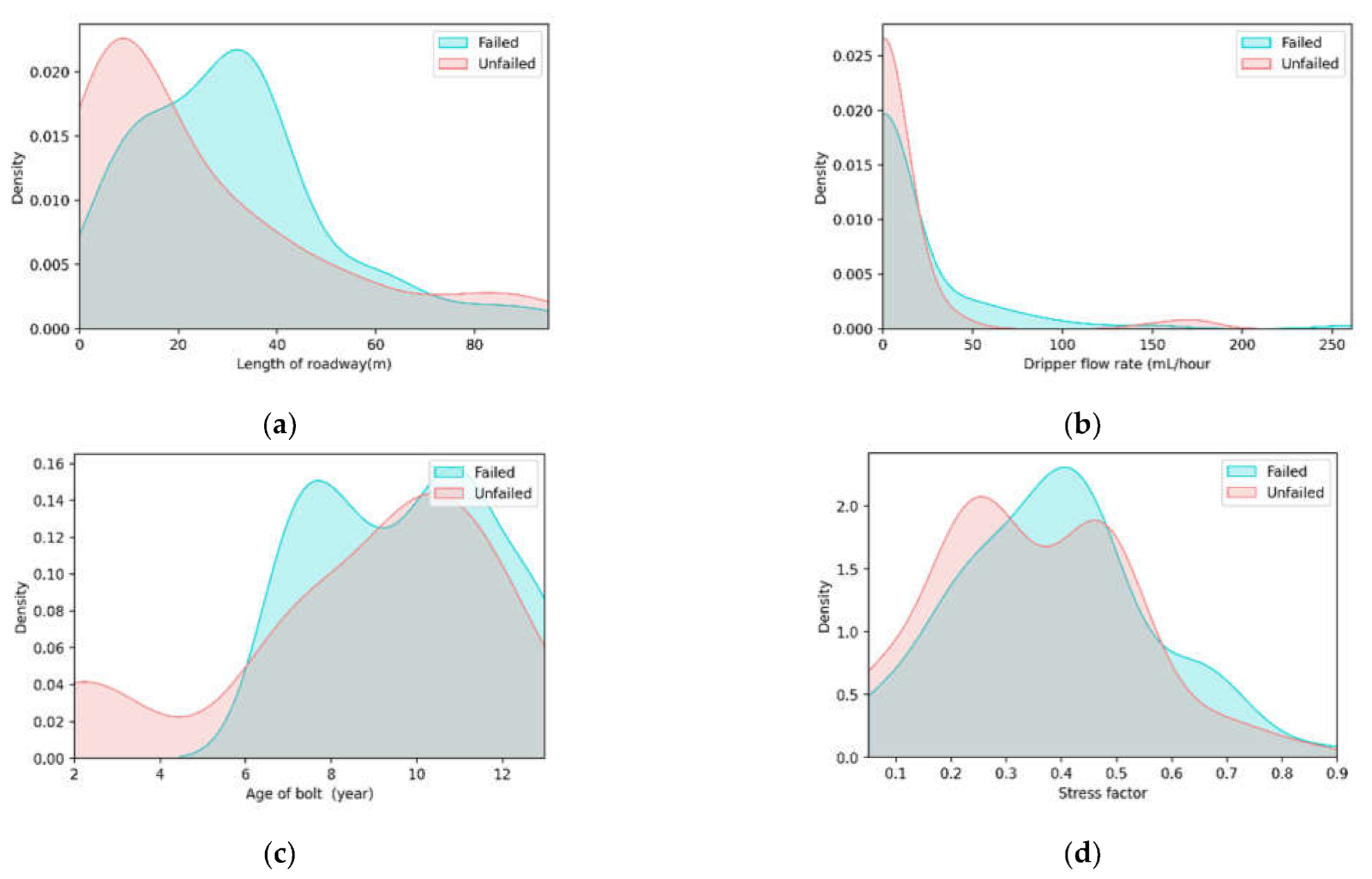
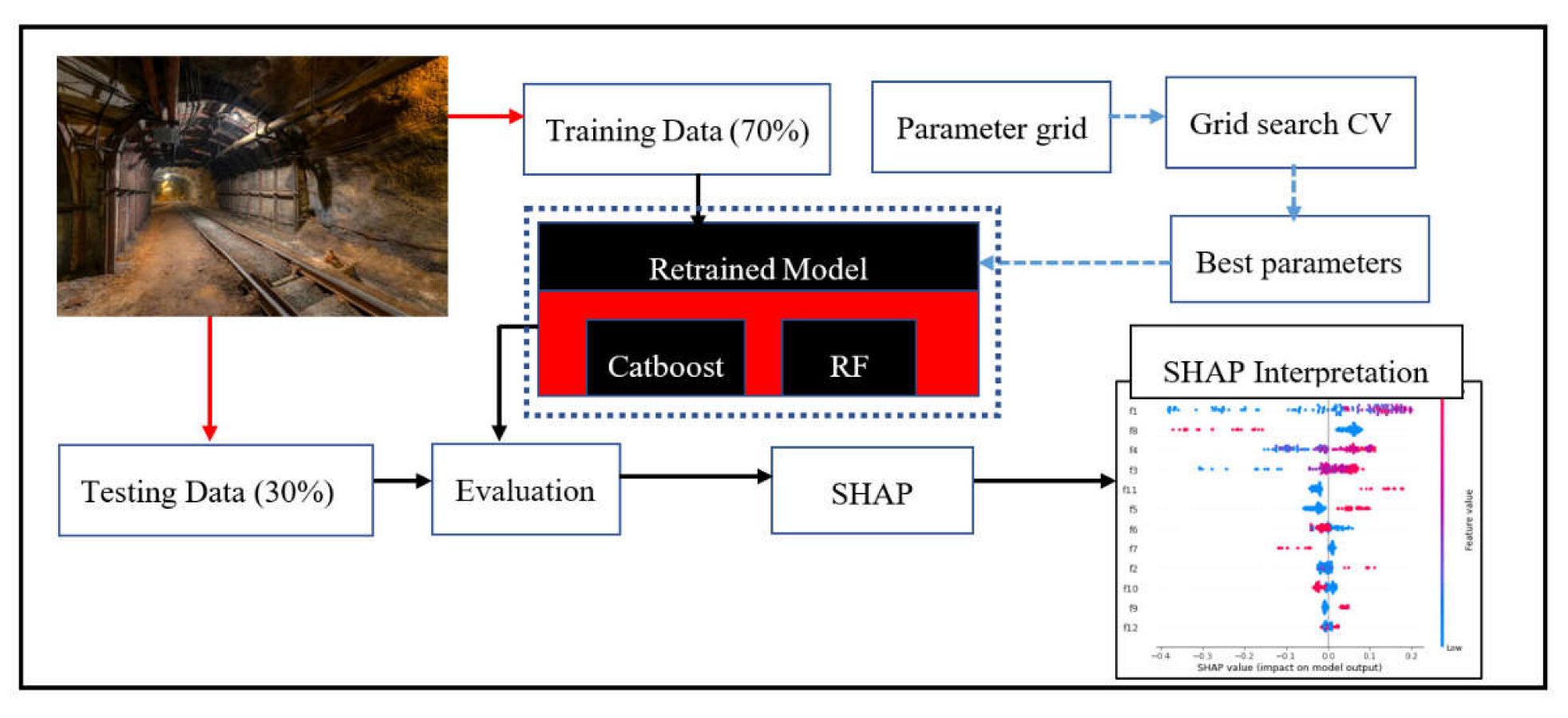
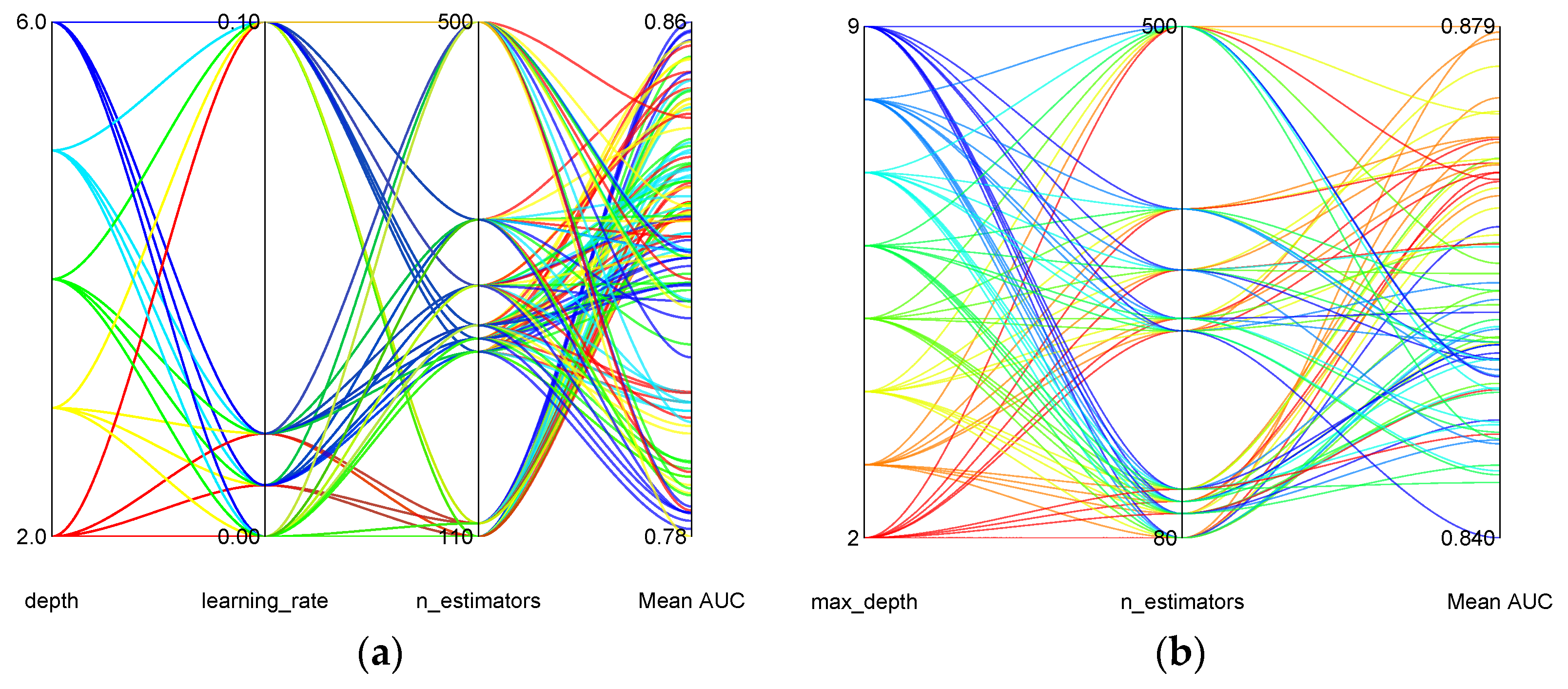
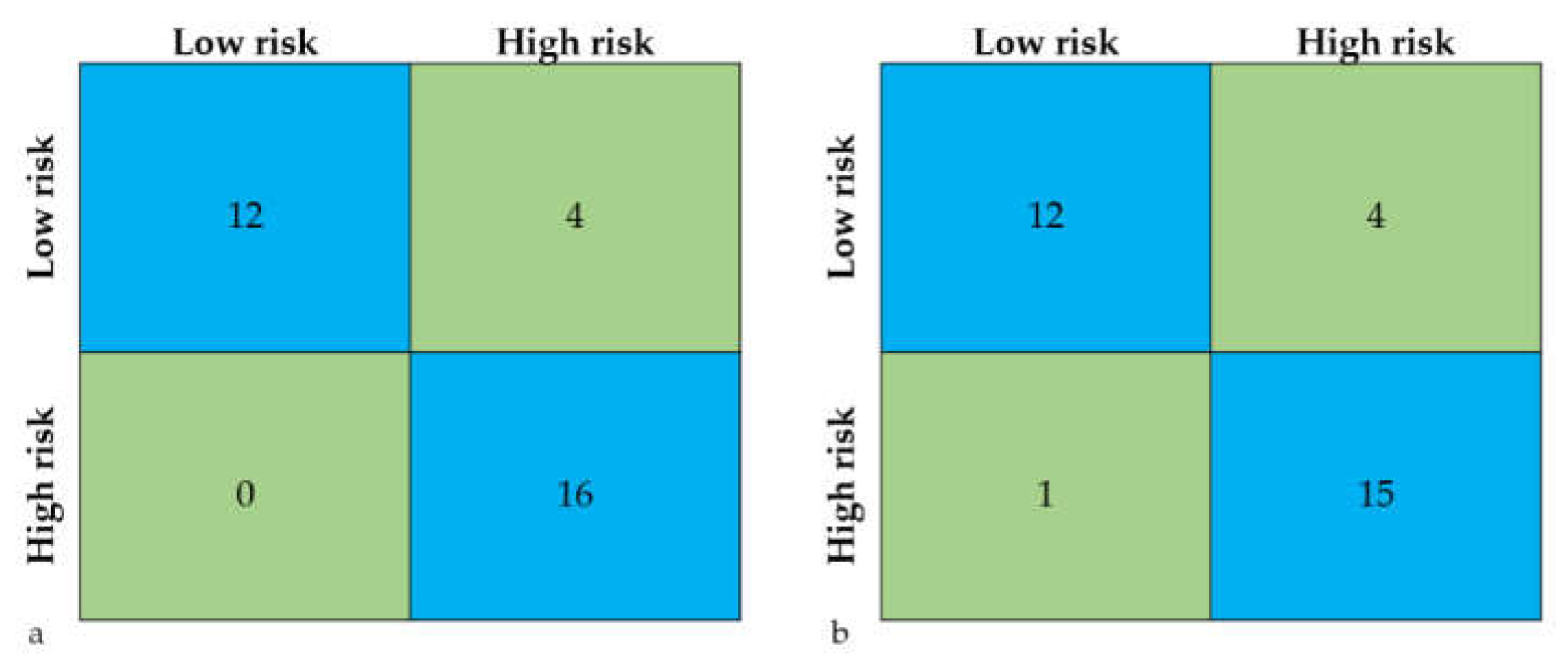
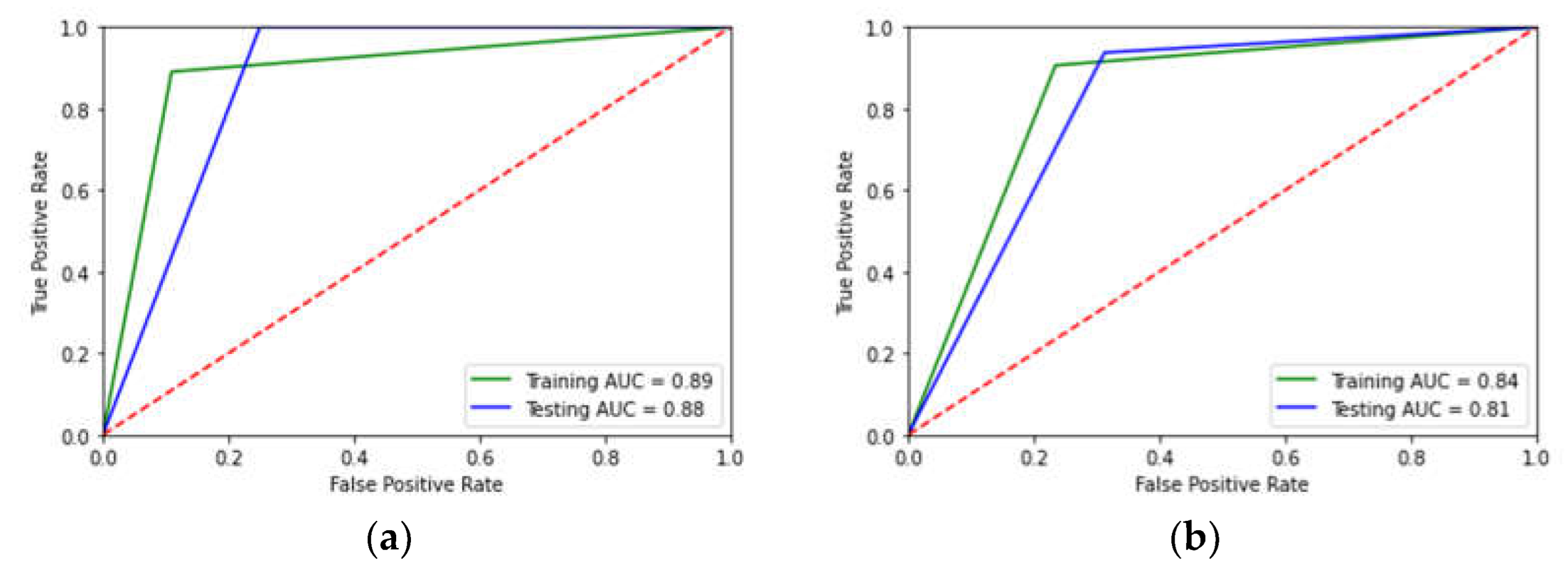
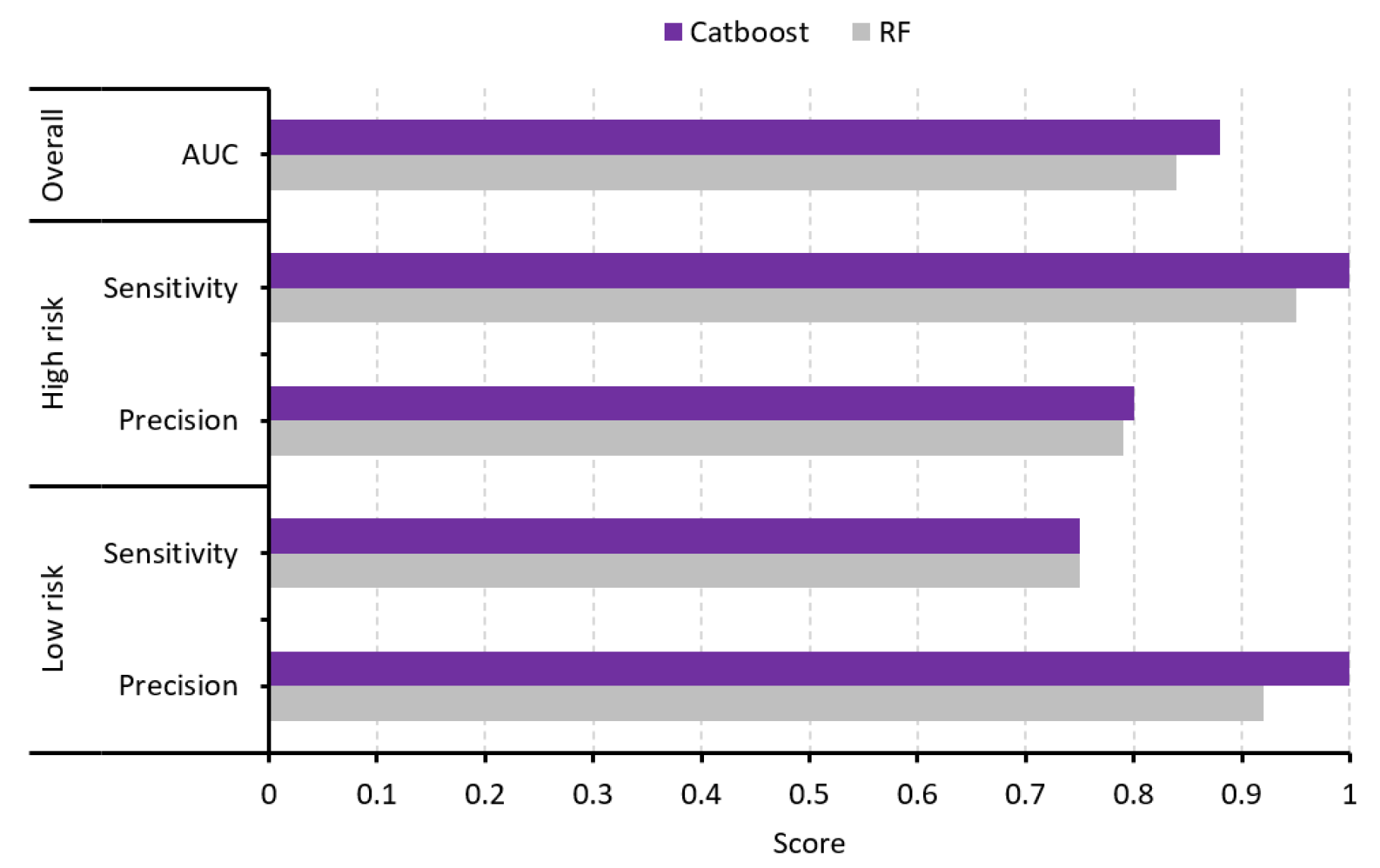


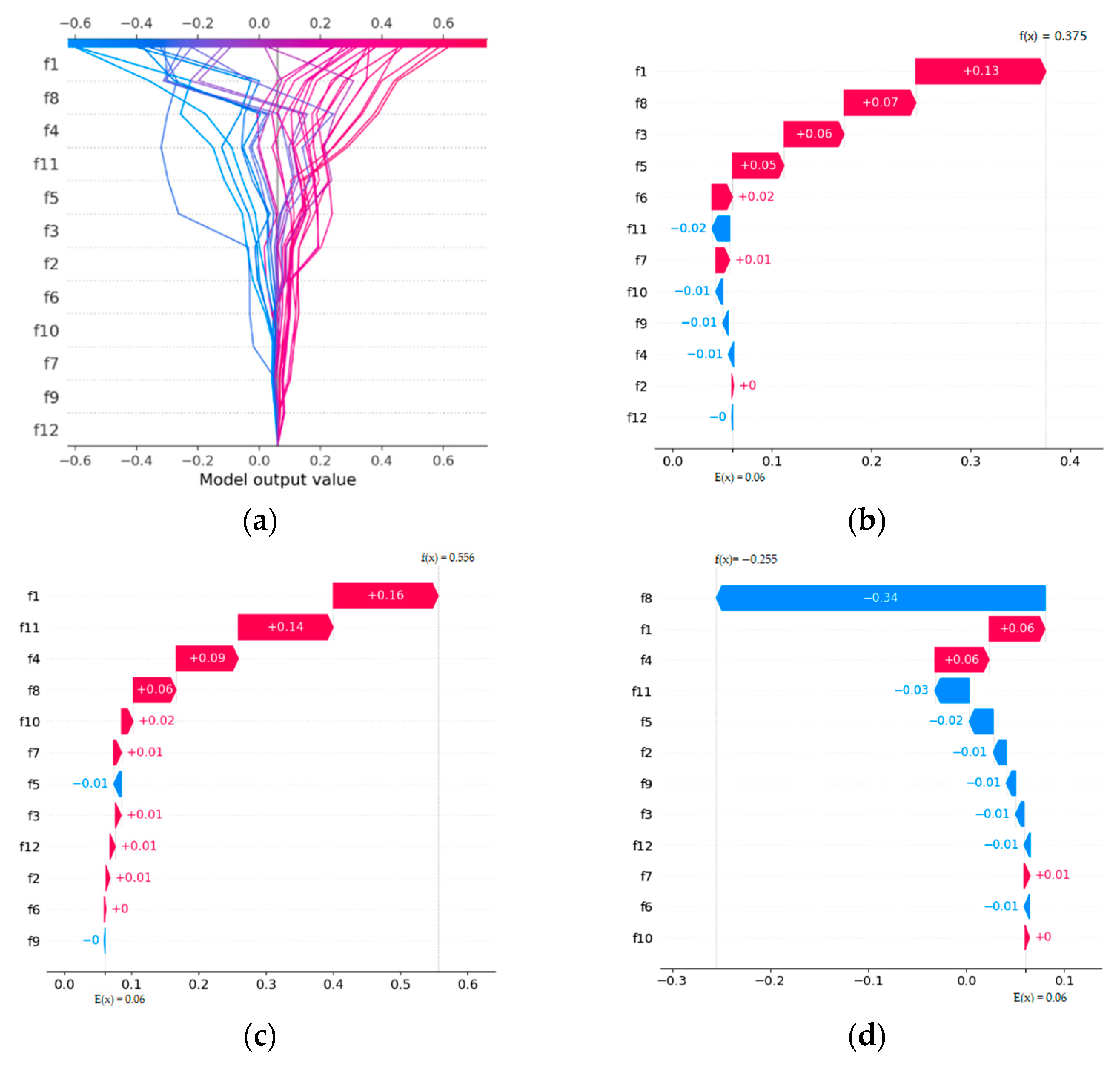
| Feature ID | Feature Name | Range | Description |
|---|---|---|---|
| f1 | Length of roadway | 5–95 m | Determines the number of bolts installed |
| f2 | Dripper flow rate | 0–261 mL/h | Recorded groundwater rate |
| f3 | Age of bolts | 2–13 years | Service age of installed bolts |
| f4 | Stress factor | 0.05–0.9 | Ratio of sum of area weighting to maximum possible weighting |
| f5 | Zone 1 | (0, 1) | Water samples with slightly higher calcium and magnesium with low sulphur |
| f6 | Zone 2 | (0, 1) | Water samples with high sulphur content |
| f7 | Zone 3 | (0, 1) | Water with low sulphur and lower calcium or magnesium |
| f8 | Headgate 1 | (0, 1) | 1 indicates that the bolt is located in headgate 1, and vice versa |
| f9 | Cut-through 1 | (0, 1) | 1 indicates that the bolt is located in cut-through 1, and vice versa |
| f10 | Headgate 2 | (0, 1) | 1 indicates that the bolt is located in headgate 2, and vice versa |
| f11 | Cut-through 2 | (0, 1) | 1 indicates that the bolt is located in cut-through 2, and vice versa |
| f12 | Headgate 3 | (0, 1) | 1 indicates that the bolt is located in headgate 3, and vice versa |
| Target | Risk of rockbolt failure | (0, 1) | 1 = High risk of failure, 0 = low risk of failure. |
| Reference | Area of Application | Remarks |
|---|---|---|
| Inan and Rahman [48] | Identify significant landslide causal factors | Identified important features such as slope, elevation, and topographic wetness index |
| Amin et al. [49] | Forecasting compressive strength of rice husk ash concrete | Discovered that the most significant factors impacting the compressive strength were the age of the concrete sample, the amount of cement, and the amount of aggregate |
| Zhang and Lin [50] | Mitigating limit support pressure (LSP) and ground surface deformation (GSD) during the tunnel excavation | Found that the soil cover depth and the horizontal distance from the existing tunnel had a major and minor influence, respectively, on the values of LSP and GSD |
| Lee et al. [51] | Prediction of quantitative rock damage using various acoustic emission parameters | Cumulative absolute energy and initiation frequency were identified as important factors for both high and low degrees of damage |
| Nasiri et al. [52] | Prediction of uniaxial compressive strength and modulus of elasticity for travertine samples | Results indicated that P-wave velocity has the highest importance in the prediction |
| Kannangara et al. [53] | Investigation of feature contribution to shield-tunnelling-induced settlement | Revealed that the larger settlements were induced during shield tunnelling in silty clay, and that low magnitudes of face pressure at the top of the shield increase the model’s output |
| Mangalathu et al. [54] | Punching shear strength estimation of flat slabs without transverse reinforcement | Showed that the material properties (i.e., the ratio of yield strength to compressive strength, and the reinforcement ratio) have a greater influence on the shear strength than the geometric parameters |
| Khan et al. [55] | Modelling coal dust explosibility | Identified that coal dust particle size and gross calorific value were the most important influencing factors on the maximum pressure of the deflagration index |
| Mangalathu et al. [56] | Failure mode and effects analysis of reinforced concrete structures | The geometric variables and reinforcement indices were critical parameters that influence failure modes |
| Barkhordari et al. [57] | Prediction of flyrock due to quarry blasting | Hole diameter was determined to be the main factor in controlling flyrock distance, followed by the powder factor |
| Wang et al. [58] | Seismic stability analysis of embankment slopes subjected to water level changes | Identified friction angle φ as the most important feature |
| Guo et al. [59] | Assessment of rock-burst risk | The results showed that tangential stress around underground openings and the uniaxial compressive strength of the rock were the most important variables |
| Metric | Formula | Equation | Description |
|---|---|---|---|
| AUC | 5 | AUC indicates how well the probabilities of the positive class are separated from the negative class, where Rtp is the true positive rate, Rfp is the false positive rate, pa is the probability of observed agreement, and pt is the probability of agreement when two classes are unconditionally independent | |
| Sensitivity | 6 | The percentage of the relevant material datasets that were correctly identified, where TP and FN denote true positive and false negative, respectively | |
| Precision | 7 | Precision represents the proportion of predicted positive cases that are real positive values [46], where FP denotes false positive. |
| Model | Low Risk | High Risk | Overall | Reference | ||
|---|---|---|---|---|---|---|
| Precision | Sensitivity | Precision | Sensitivity | AUC | ||
| Catboost | 1 | 0.75 | 0.80 | 1 | 0.88 | This study |
| RF | 0.92 | 0.75 | 0.79 | 0.95 | 0.84 | This study |
| PCA-SVM | - | - | - | - | 0.86 | Jiang et al. [20] |
| SVM | - | - | - | - | 0.83 | Jiang et al. [20] |
| GTB-SVM | - | - | - | - | 0.81 | Jiang et al. [20] |
| Feature ID | Sample Number | ||
|---|---|---|---|
| (1) | (2) | (3) | |
| f1(m) | 75 | 18 | 38 |
| f2 (mL/h) | 0 | 0 | 0 |
| f3 (years) | 12 | 10 | 10 |
| f4 | 0.3 | 0.45 | 0.4 |
| f5 | 1 | 0 | 0 |
| f6 | 0 | 1 | 1 |
| f7 | 0 | 0 | 0 |
| f8 | 0 | 1 | 0 |
| f9 | 0 | 0 | 0 |
| f10 | 1 | 0 | 0 |
| f11 | 0 | 0 | 1 |
| f12 | 0 | 0 | 0 |
| Actual | 0 | 0 | 1 |
| Predicted | 1 | 0 | 1 |
Publisher’s Note: MDPI stays neutral with regard to jurisdictional claims in published maps and institutional affiliations. |
© 2022 by the authors. Licensee MDPI, Basel, Switzerland. This article is an open access article distributed under the terms and conditions of the Creative Commons Attribution (CC BY) license (https://creativecommons.org/licenses/by/4.0/).
Share and Cite
Ibrahim, B.; Ahenkorah, I.; Ewusi, A. Explainable Risk Assessment of Rockbolts’ Failure in Underground Coal Mines Based on Categorical Gradient Boosting and SHapley Additive exPlanations (SHAP). Sustainability 2022, 14, 11843. https://doi.org/10.3390/su141911843
Ibrahim B, Ahenkorah I, Ewusi A. Explainable Risk Assessment of Rockbolts’ Failure in Underground Coal Mines Based on Categorical Gradient Boosting and SHapley Additive exPlanations (SHAP). Sustainability. 2022; 14(19):11843. https://doi.org/10.3390/su141911843
Chicago/Turabian StyleIbrahim, Bemah, Isaac Ahenkorah, and Anthony Ewusi. 2022. "Explainable Risk Assessment of Rockbolts’ Failure in Underground Coal Mines Based on Categorical Gradient Boosting and SHapley Additive exPlanations (SHAP)" Sustainability 14, no. 19: 11843. https://doi.org/10.3390/su141911843
APA StyleIbrahim, B., Ahenkorah, I., & Ewusi, A. (2022). Explainable Risk Assessment of Rockbolts’ Failure in Underground Coal Mines Based on Categorical Gradient Boosting and SHapley Additive exPlanations (SHAP). Sustainability, 14(19), 11843. https://doi.org/10.3390/su141911843






